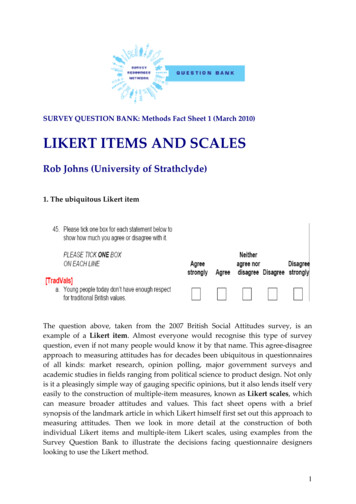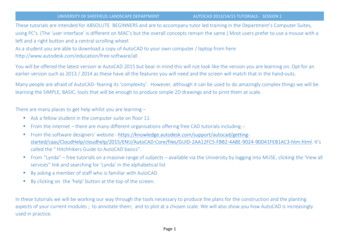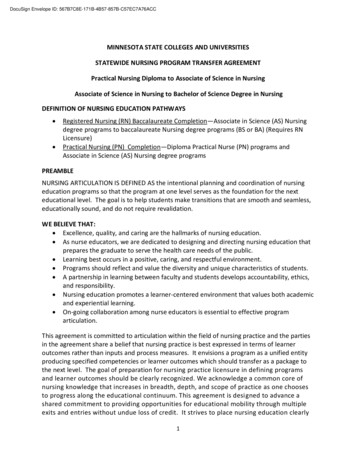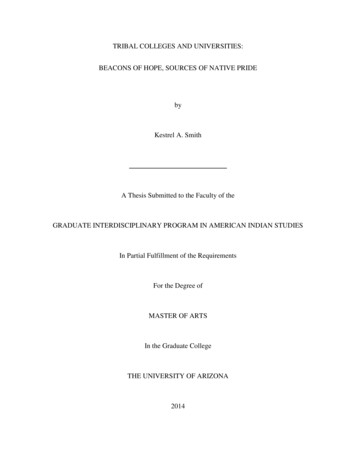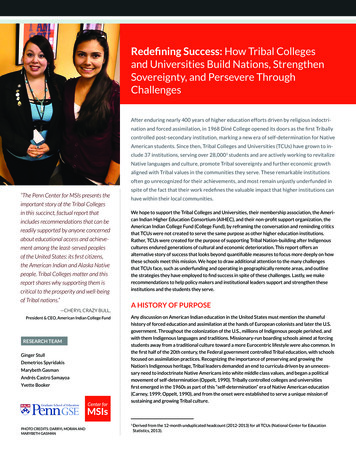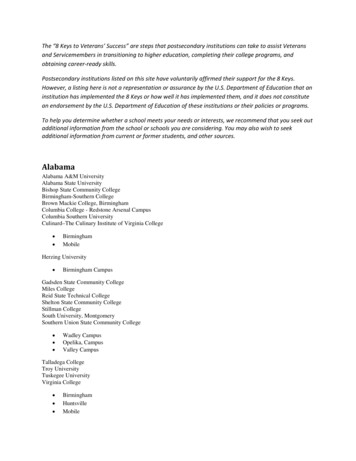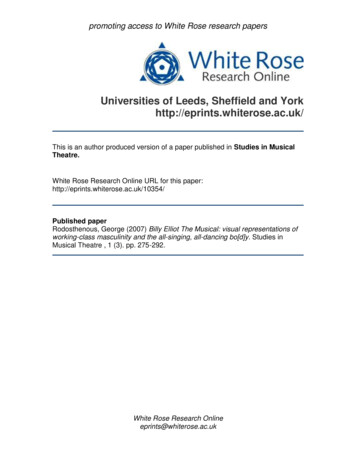
Transcription
promoting access to White Rose research papersUniversities of Leeds, Sheffield and Yorkhttp://eprints.whiterose.ac.uk/This is an author produced version of a paper published in Studies in MusicalTheatre.White Rose Research Online URL for this ed paperRodosthenous, George (2007) Billy Elliot The Musical: visual representations ofworking-class masculinity and the all-singing, all-dancing bo[d]y. Studies inMusical Theatre , 1 (3). pp. 275-292.White Rose Research Onlineeprints@whiterose.ac.uk
ARTICLE NAMEBilly Elliot The Musical: Visual representations of working-classmasculinity and the all-singing, all-dancing bo[d]y.AUTHOR NAMEGEORGE RODOSTHENOUSABSTRACTAccording to Cynthia Weber, „[d]ance is commonly thought of as liberating,transformative, empowering, transgressive, and even as dangerous‟. Yet, ballet as amasculine activity, it still remains a suspect phenomenon. This paper will challengethis claim in relation to Billy Elliot the Musical and its critical reception. Thetransformation of the visual representation of the human body on stage (from anephemeral existence to a timeless work of art) will be discussed and analysed vis-a-visthe text and sub-texts of Stephen Daldry's direction and Peter Darling‟s choreography.The dynamics of working-class masculinity will be contextualised within theframework of the family, the older female, the community, the self and the act ofdancing itself.KEYWORDSBilly Elliot, masculinity, male dancers, dancing musicals, representations of the maleAUTHOR BIOGRAPHYGeorge Rodosthenous is Lecturer in Music Theatre at the School of Performance andCultural Industries of the University of Leeds. He is the Artistic Director of the theatrecompany „Altitude North‟ and also works as a freelance composer for the theatre. Hisresearch interests are „the body in performance‟, „refining improvisational techniquesand compositional practices for performance‟, „devising pieces with live musicalsoundscapes as interdisciplinary process‟, „updating Greek Tragedy‟ and „The BritishMusical‟. He is currently working on the book Theatre as Voyeurism: the Pleasure(s)of Watching.AUTHOR INSTITUTIONAL AFFILIATIONLecturer in Music TheatreSchool of Performance and Cultural Industries, University of LeedsAUTHOR ADDRESSESDr George RodosthenousSchool of Performance and Cultural Industries,University of Leeds, Leeds LS2 9JT
IntroductionThis paper examines the visual representations of working-class masculinity portrayedin Stephen Daldry‟s stage musical adaptation of the film Billy Elliot (2000). After abrief discussion of the portrayal of the male ballet dancer in the dancing scene sincethe 1990s and the inherent voyeuristic inclinations of contemporary audiences, theanalysis will focus on five aspects of male presence in Billy Elliot the Musical (2005).The dynamics of working-class masculinity will be contextualised within theframework of the family, the older female, the community, the self and the act ofdancing itself. These aspects will be referenced using reviews of the musical versionof the work and articles written on the film of Billy Elliot. The discussion will suggestalso that the all-singing, all-dancing bo[d]y is transformed on stage from an ephemeralphenomenon to an iconic symbol of its age. However, have today‟s audiencesconditioned their gendered gaze to allow for the male ballet dancer to dominate thecontemporary stage? Or do we still control our social perceptions and culturalassociations with out-of-date images of the past? Have popular perceptions about themale ballet dancer changed? Is there a birth of a new male dancer phenomenon?Even if nineteenth-century ballet became „so concerned with the display offemale bodies that male characters became almost an impossibility (or reduced to thekind of mime and choreographic support-work)‟ (Henson 2007: 5), the twentiethcentury had its notable exceptions with the charismatic Vaslav Nijinsky, the legendaryRudolf Nureyev (on stage), the athletic Gene Kelly, the suave Fred Astaire and themagnetic John Travolta (on stage and screen). If we examine the dance scene sincethe 1990s, we would observe that the male ballet dancer has been re-invented in the
theatre canon. 1 Mathew Bourne is partly responsible for this new trend of presentingthe male dancer on stage, with examples like his male Swan Lake (1995), which isalso used at the end of the film version of Billy Elliot and The Car Man (2000),changing the popular assumptions that ballet as a masculine activity is a suspectphenomenon. And this proves the point that male ballet is a much more complexactivity than just that. Companies like DV8 and Lloyd Newson have blurred theboundaries between the classical male ballet dancer and the „new‟ male dancer withworks such as Dead Dreams of Monochrome Men (1989) and Enter Achilles (1995).These works erotised, and homo-erotised the male body giving it a new politicalstatus. Michael Clark and Wim Vandekeybus re-negotiated masculinity and itspositioning within the canon while other choreographers such as Javier de Frutos2have liberated the male body by exposing the dancers and himself with naked displaysof unrestrained emotion.The androgynous male ballet dancer has been replaced by strong musculargymnasts who treat contemporary dance as a new form of sport and who are morethan happy to display their muscles to their audiences. Spectacular shows by Cirquedu Soleil and new musical extravaganzas such us Stomp, Tap Dogs and Riverdancehave re-defined the presence of the male on stage. The stereotypical expectations ofballet (for example, the female body being the normal object of spectator‟s desire)have now been reversed. Carlos Acosta of the Royal Ballet features solo in as many1The scope of this study does not allow us to have a more extensive overview. On the other hand, thereis a dearth of academic writing on the male dancer. Notable exceptions are Ramsay Burt‟s The MaleDancer: Bodies, Spectacle, Sexualities (1996) and Michael Gard‟s Men Who Dance: Aesthetics,Athletics & the Art of Masculinity (2006).2Award-winning choreographer Javier de Frutos (born in Venezuela in 1963) is currently the ArtisticDirector of Phoenix Dance Theatre. His recent work includes choreography for the musicals Cabaret(West End) and Carousel (Chichester).
posters as his fellow ballerinas, while the sensual Joaquin Cortes continues to performin sell-out houses all over the world.3Popular perceptions and attitudes like „real boys don‟t go to dance classes‟,(Gard 2001: 213) are beginning to disappear. More boys are now dancing and throughtheir dance they have managed to uplift the anti-male dancer taboos. Henson writesthat Billy Elliot‟s dance shows his „transformation from boy to man, the struggle toachieve and the liberating power of artistic expression [it] also communicate[s] apowerful view of male balletic dancing, a form of male performance prone tostereotype and misunderstanding. Billy is no “sissy” he is an innovator, an achiever,a sportsman‟ (Henson 2007: 1).But how do the audiences react to changes in visual representations ofmasculinity? The voyeuristic tendencies of recent audiences, (apparent in audiencebehaviours towards so-called reality television, see Big Brother phenomenon)together with a desire to come into closer, more direct contact with the dancer‟s flesh,have created new forms of performance, whether site-specific, or even one-to-oneencounters. The body physicality of the „new‟ male dancer signifies strength andphysical presence which might have been associated with working-class ethics andmanual labour in the past. Images of males dancing are being released from theirhomoerotic associations and invite new semiotic readings. Karen Henson notes on theaudience-performer relationship: the audience now „consumes with delight butdistance, nuance but also desire and pleasure‟ (Henson 2007: 9).Since the late 1990s, masculinity 4 started emerging as a major subject inacademic discussions, works of art and stage productions. This revolution was also3The best selling and most discussed show during the 2006-7 theatrical season in Athens (Greece) wasDemetris Papaioannou‟s 2, a dance theatre extravaganza featuring 22 males.4This paper will not attempt to present the „bo[d]y and masculinity‟ within a gender or sexualityframework. This has been explored by Mangan in Staging Masculinities: History, Gender,
felt in films such as Brassed Off (1996) and The Full Monty (1997) which dealt withthe alienation of the Northern male from his traditional habitat – the working men‟sclub and the brass band – and looked at life from a male perspective. The managementof male energy (either by playing in bands or through stripping in the respective filmsmentioned above) is fully explored in Billy Elliot the Musical through aggressivedance sequences and moments of explosive percussive rigour.Billy Elliot the Musical has enjoyed positive critical acclaim including CharlesSpencer‟s verdict that it is „the greatest musical yet‟, a work where „there is rawness, awarm humour and a sheer humanity that is worlds removed from the soullessslickness of most musicals‟ (Spencer The Daily Telegraph 12 May 2005). The showportrays a masculine crisis in a coal mining village in England in 1986 and exploresfamily relationships in a most intricate and personal way. In that respect, dance comesinto direct opposition with the working-class practices of the males of the miningcommunity: it is ridiculed and equated with homosexuality. Cynthia Weber, however,insists that „even though it might popularly be read otherwise, ballet [and in our casedance] is not necessarily a queer space for men Billy thinks of dance as a male andmasculine space‟ (Weber 2003). This paper will apply Weber‟s claim and use themusical version of Billy Elliot as its main case study for its findings.Solidarity (of the community) and the male individual: brothers fighting[T]he musical counterpoints Billy‟s personal triumph against the community‟sdecline.(Billington The Guardian 12 May 2005)Performance (2003), Shilling in The Body and Social Theory (2003), Turner in The Body and Society(1996), Petersen in Unmasking the Masculine: ‘Men’ and ‘Identity’ in a Sceptical Age (1998), Watsonin Male bodies: health, culture and identity (2000), Lehman in Running Scared: Masculinity and the
Billy Elliot, a miner‟s son, is found amidst the confusion of daily struggles whichinvolve the miners standing restlessly on picket lines at the colliery gates. Thefighting tends to break out when the police attempt to escort strike breaking minersinto the pit. This is also a reflection of Billy‟s home working-class environment wherehis brother (also a miner) is fighting with his father on issues directly related to thestrike. One of the main differences of the film version of Billy Elliot and its stagetransfer is that in the latter there is more opportunity to indulge in moments of strikingbeauty where issues of class and conflict are explored through Peter Darling‟schoreography5 and Elton John‟ s music. Benedict Nightingale comments thatwe get dances of police and miners that start in Keystone style but get more menacingwith the introduction of batons and clubs, and end with a stupendous number inwhich the cops become a terrifying wall of riot shields against which Billy fluttersand bangs like a distracted moth.(Billington The Times 12 May 2005)The stage becomes a platform to explore one of the main issues of ThatcheriteBritain: the complete disempowerment of the workers‟ unions. The workers sing thesong „Solidarity‟ that reflects the traditional socialist chant „The workers united shallnever be defeated‟ – the fabled „unity is strength‟ slogan of the trade union tradition:Solidarity, solidaritySolidarity for everAll for one and one for allRepresentation of the Male Body (1993), Middleton in The Inward Gaze: Masculinity & Subjectivity inModern Culture (1992), Men, Masculinity, and the Media (1992) edited by Craig and others.5Peter Darling‟s choreography credits include the musicals: The Lord of the Rings, Our House, Closerto Heaven, Merrily We Roll Along, Candide and Oh! What a Lovely War.
We are proud to be working class.(„Solidarity‟, Billy Elliot the Musical)Figure 1: Billy Elliot dancing. Photo: David ScheinmannThe status quo, that Billy is trying to overturn, clashes with his desire to dance. Thislocks him out of the „macho‟ male world of the miners and makes him different fromthe rest of the males. Billy wants to break out of this solidarity and hopes for the daywhen he will „fly away‟ and even if this will make him an outcast, he will find a bettertomorrow away from the „stifling confines of the enclosed and embattled community‟(Kink 2002).The binary of the community and the individual gains a new dimension whichbecomes confronted with an element of competition amongst the males of that
working-class community. Billy and his brother are fighting for two different ideals:personal individuality and solidarity. Billy wants to break free, his brother fights tomaintain the male traditions of colliery workers. Lancioni notes that „the frustrationand hopelessness of the striking coal miners of Durham County, England, arecertainly real enough. A postindustrialized society is draining them of hope and selfrespect‟ (Lancioni 2006: 726). This is felt rather explicitly with the failed strikeactions of the workers and the gloomy fact that they are fighting an already lost battle.In the first song „The Stars Look Down‟, there is a sense of a hymn, fighting the goodfight against the forces of darkness. Lee Hall‟s lyrics reflect this:And although your feet are wearyAnd although your soul is wornAnd although they‟ll try to break youAnd although you‟ll feel aloneWe will always stand togetherIn the dark, right through the stormWe will stand, shoulder to shoulderTo keep us warm.(„The Stars Look Down‟, Billy Elliot the Musical)
(West End) and Carousel (Chichester). posters as his fellow ballerinas, while the sensual Joaquin Cortes continues to perform . musical version of Billy Elliot as its main case study for its findings. Solidarity (of the community) and the male individual: brothers fighting [T]he musical counterpoints Billy‟s personal triumph against the community‟s decline. (Billington The Guardian 12 .
